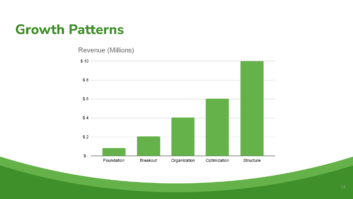You know that the cost of labor is killing you, and it makes you mad. So mad, that you start to resent your workers whenever they take a two-minute coffee break.
But part of you knows better. That’s the part that remembers all the two-minute breaks you used to take (and when your boss glared at you). So you keep your mouth shut, and internalize the anger. Have you thought about spending more time at the local tavern? That’ll numb the pain. How about smacking a few at the driving range. That always feels good.
Wake up. All the beer and chip shots in the world won’t fix your cost of labor problems. The reason you’re upset is because you have created a process that makes it next to impossible for your workers to be efficient. You know–deep down–that you aren’t making any money on your labor costs. And if you’re like most custom installation companies, you’re right.
Think back to your days as an employee, and all the frustration you felt in your day-to-day job. You probably compiled a mental list of a dozen ways your life would be easier (and more productive) if it weren’t for some lame rule or procedure your company made you follow. After having spent years battling the system, you finally relented. You gave in to a faulty process, telling yourself, “One day, I’m gonna run a company, and man it’s gonna be so much better than this.” So here you are, with employees who feel crushed by the lame rules you impose. Break the chain, man. Break the chain.
Can you Make Money on Labor?
Right now your company is set up to earn its profit on the sale of product. You’re probably not earning anything on your installation and engineering labor, and that’s a problem for three reasons:
1) Manufacturers have a vested interest in reducing prices, not raising them.
2) Price competition is growing.
3) You compete by distinguishing yourself with your expertise, not by the products you sell.
Aren’t manufacturers your friends? Sure they are. But manufacturers want to deliver the greatest value to the end user. That means increasing quality, features, and performance with each new product offering, without raising prices.
Look at manufacturers of leading-edge technologies, like DLP projectors. Just last year an entry-level DLP sold for $10k. Recently, several manufacturers announced $3k models. The average price of a DLP projector will plummet in the next few years. The same holds true for plasma TV and touch panel control systems. For example, it will take you just as long to spec, sell and install today’s $20k plasma TV as it will next year, when the price drops to $12k. But you’ve earned less.
Don’t be Fooled by Today’s Margins
I predict that margins in the custom installation business will begin plummeting. I’ll give you three good reasons why this will happen. First, there will be increased competition in your market as the number of custom installers increases. New dealers will compete by discounting or by being more efficient than you are, charging less for a higher quality installation.
Second, I see the large retail chains moving into the business, and they just have no idea what they’re doing. To these chains, installation is just another way of moving more boxes out the door, so they discount the product, then charge next to nothing to install it.
That’s gonna hurt.
And third, as the market matures, more customers will take the time to investigate the components of their systems. They’ll be especially aware of the “big ticket” items in their systems–like the cost of the projector.
And with virtually every product either available or priced for review on the Internet, you’ll be questioned on the price of your expensive items more often than today. It will become harder to subsidize your business through high-dollar margin product sales as these items come down in price.
When Product Margins Go Down, You Lose
Because you’ve tied your profitability to product margins, and not to labor, your profit will decrease as margins erode. That’s the trap of using a retail-pricing model to run a custom business. Face it, the traditional retailer earns money by selling as many boxes as quickly as possible, but the typical custom installation dealer makes money by adding more and more value to the few boxes he sells.
You add value every time you recommend a product, install it, program it, train the customer how to use it and then service it when things go awry. That’s the nature of the custom installation business; you compete best when you feature your value-added capabilities. Remember that customers ultimately choose to use your firm not because you sell Runco projectors at a lower price than your competition, but because you have convinced them you are more capable of delivering a first-class theater system. You have distinguished yourself on the abilities of your labor force–your designers, engineers and installers. So doesn’t it make sense to get paid for these abilities?
Okay, So How Do You Make Money on Labor?
Let’s get back to the where we started. Remember the grumbling you were doing when your installers were drinking coffee instead of actually working? You saw an asset (your employees) being squandered. And squandering is a terrible thing to watch.
Your job as a manager is to derive the greatest benefit possible from each asset in your operation. You should earn a respectable margin on your products and your personnel. But there’s a difference between your products and your personnel. You buy your products wholesale–they come to you fully manufactured and ready for sale. But personnel are more like raw material. It’s your job to implement an efficient process that allows your personnel to do their jobs well. Let’s look at the development of an efficient installer. First, hire the right person. Then give that person the tools he or she needs to be wildly successful. These tools include a finely honed product plan, a simple corporate communication structure, product and installation training and all the right gadgets in their truck.
Product Plan: Limit your product offerings to one brand of each discrete product. For example, you only need one projector between $15 and $20k, one A/V receiver between $3 and 4k. One outdoor speaker model between $400 and $600 per pair. The fewer products you sell, the easier it is to buy them, stock them and train your installer how to use them. Remember that the customer didn’t choose to work with you because you have a great selection of projectors. They work with you because you have a great staff.
Communication is critical: Most installers waste over one hour every day making sense of your organization’s poor communication structure. They just don’t get good, fresh, timely information. Think about it. If you asked your installer right now what he’s doing tomorrow, he probably only has a vague idea. “I’m on the Smith job,” he says. Doing what? He’ll figure that out tomorrow.
That’s the scary part of the custom installation business. You never quite know what tomorrow brings, but you expect the installer to make it all work. Is this natural? I don’t think so. I think it’s just a sign of disorganization.
Just last week I had a DSL line installed in my offices. All paperwork was handled by a central dispatch center. The installer showed up, worked for 1 hour stringing cables, found a problem in the phone line, and left. The next day I received a call from dispatch that the phone company required 3-4 days to fix the line, at which point the installer would return to hook it all up.
When I spoke to the installer, he let me know that dispatch handled the entire installation process, and would be on top of it. It wasn’t his job to figure it out. He just showed up, did the work, called for support, and drove off to the next job. That’s a good way to keep an installer efficient. Because he’s not expected to do anything more than install.
Surely installation of a multi-room system and theater is more complicated than running a twisted pair for DSL, but the process is similar. My DSL installer was given good information: Show up at Bay Audio at 1 p.m., install a DSL line. When things didn’t work out, he knew exactly what to do: Call dispatch and report the problem. Then dispatch knew what was next: Call Pacific Bell and have the line fixed.
This is not brain surgery. It’s just a simple communication process that keeps everybody moving along at a fast clip.
Product and installation training: Let’s face it. You don’t really formally train your installers. You just show them how you’ve always done it. Now admit that you never formally train your installers. It’s okay, but as long as you know this, make their life easy by limiting the number of things they need to master. That brings us back to point #1: Limit your product offerings. The fewer kinds of systems you sell, the easier it is to learn them.
I’m shocked when I see custom installation companies with three brands of control systems. You need Crestron, Elan and Phast why? Are you nuts?
The right tools: What did Dad always say? The right tools for the right job. But when it comes to installers, most managers “cheap out” and make their staffs work with sub-optimal tools. Remember that your installers are an asset for your company. Your job is to derive the most benefit possible from your assets. And yet, you give them less than state-of-the-art tools in their toolbox. Wanna bet? If I gave you the tools your installers use and told you to do their job, you’d wail like a baby. Cough it up. Start treating your labor like the focal point of your business.
The best way to begin earning money on labor is to change the way you see your employees. They aren’t a necessary evil. They are the crux of the business, and the one element of your marketing plan that distinguishes you from your competition.
By focusing a ton of attention on this asset, you will begin to see where the inefficiencies lie in your organization. You will begin to value their time. And you will develop a more tangible, apparent selling tool (your capabilities) that will allow you to begin charging appropriately for their time.
How can you possibly charge more for labor if your labor isn’t worth more? Your job as a marketer is to heighten the value, and make it apparent to your customers. Your job as a manager is to simplify their day-to-day process so they can install more products in a shorter period of time.
As the frustrations of their day begin to decrease (with a limited product plan, simple communications, and the right tools), your installers will gain greater control over their success. This leads to higher productivity, a greater return for the organization and more money for your installers.
Plus, you’ll feel a lot better about the two minutes they spend sipping their coffee.
Ira Friedman is president of Bay Audio in San Francisco, California.






